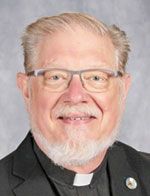That All May Be One / Fr. Rick Ginther
Passover celebrates Jews’ liberation from slavery into freedom
 (We are in the Easter season. Ramadan ended on April 8, and Jews are about to enter Passover. What follows is a description of the seder meal, the feast that begins Passover. My thanks to Dr. Alan Bercovitz, who is Jewish, for the following column.)
(We are in the Easter season. Ramadan ended on April 8, and Jews are about to enter Passover. What follows is a description of the seder meal, the feast that begins Passover. My thanks to Dr. Alan Bercovitz, who is Jewish, for the following column.)
Each year on the Hebrew calendar, Passover begins on the 15th day of the month of Nisan. By the Hebrew calendar, the current year is 5784.
This corresponds to our western calendar: sundown on April 22, 2024. Passover ends at sundown on April 30 (Nisan 22).
Passover and Easter are both springtime celebrations. Let’s think about how similar these traditions are.
Redemption and hope are themes shared at both Passover and Easter. We are all called on to celebrate, observe, pray and share with our families and friends.
As Passover begins, families gather for the Seder meal.
Seder means “order.” All Jewish seder meals worldwide follow the same 14 parts in the same prescribed order, just as our ancestors did in times past.
We read from the Hagaddah (“the telling,” a book which guides the Seder meal). The Torah (first five books of the Bible) commands us to tell this story to our children and grandchildren, as our parents and grandparents did in times past.
As we gather, the leader has before him/her the Seder plate. On the Seder plate rests:
-
The Pesach. A roasted bone, symbolic of the special lamb brought to the temple as an offering to God.
-
Moror. Bitter herbs, symbolic of the bitterness of slavery.
-
Charoses. A combination of apples, cinnamon, nuts and wine, symbolic of the clay used by the slaves to make bricks for the Pharaoh.
-
Beitsa. An egg, symbolic of continuity of life, for there is no beginning and no end.
-
Karpas. Parsley, symbolic of new life and a feeling of hope.
-
Wine. Drunk four times, symbolic of God’s four promises of freedom.
-
Salt water. Symbolic of sad, bitter tears shed by the slaves of ancient Egypt, and those who are not free today.
-
Matzoh. Unleavened bread. As the Jewish people fled Egypt, there was no time for bread to rise.
-
Elijah’s Cup. The prophet Elijah is invited to enter all homes during the Seder meal.
At Passover, we tell the story of our redemption from slavery.
Moses, whose name means “drew him out of the water,” was saved from the Nile River by Pharaoh’s daughter. He was raised as the Pharaoh’s grandson. As he grew, and as the Jewish people were enslaved, God told Moses to go to the Pharaoh and say, “Let my people go.”
When Pharaoh refused, God punished Egypt with 10 plagues, the last being the death of firstborn sons.
The Jewish people marked their doorposts with the blood from a sacrificed unblemished lamb, a sign that the angel of death should pass over their homes and spare their first-born sons.
Because of these plagues, Pharaoh told the Jewish people they could leave. In their haste, they did not have time to leaven the dough.
When they reached the Red Sea, Pharaoh changed his mind and demanded his army secure their return to slavery. Through God, Moses parted the Red Sea, allowing the Jewish people to go forth into freedom.
Passover celebrates this liberation from slavery into freedom. We celebrate this history and re-tell this story as the Torah commands.
We both remember and observe. We invite family, friends and even strangers into our home, as we are told, “Let those who are hungry come and eat.”
(Father Rick Ginther is director of the archdiocesan Office of Ecumenism and Interreligious Affairs. He is also the pastor of Our Lady of Lourdes Parish in Indianapolis.) †
 (We are in the Easter season. Ramadan ended on April 8, and Jews are about to enter Passover. What follows is a description of the seder meal, the feast that begins Passover. My thanks to Dr. Alan Bercovitz, who is Jewish, for the following column.)
(We are in the Easter season. Ramadan ended on April 8, and Jews are about to enter Passover. What follows is a description of the seder meal, the feast that begins Passover. My thanks to Dr. Alan Bercovitz, who is Jewish, for the following column.)